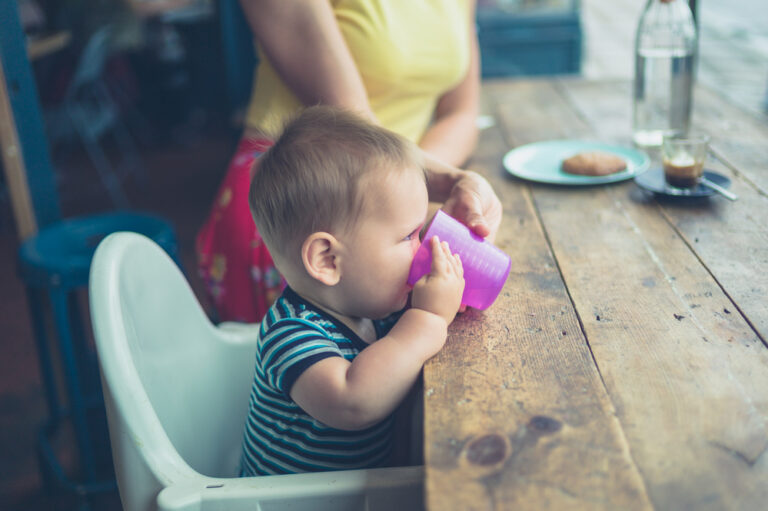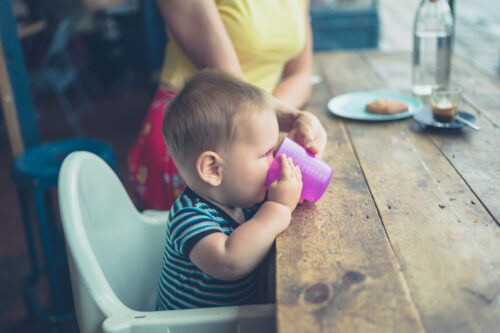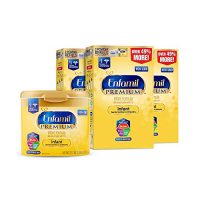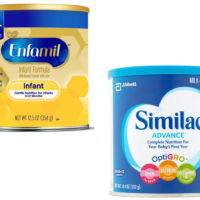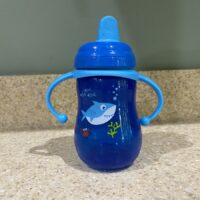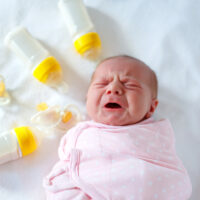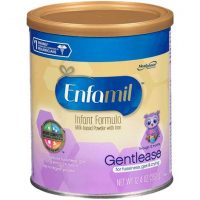It seems like such a simple task. You raise the cup to your lips and take a sip.
Unfortunately, when the time comes to teach your baby how to drink from an open cup, this concept can be quite difficult to grasp.
However, for the mom who is ready for the bottles and sippy cups to retire and the open cup to make its debut, here are some easy techniques to get your baby drinking like a big kid!
How to Teach Baby to Use an Open Cup
Drinking from an open cup is easier said than done. Why? For the entirety of your child’s existence, they have consumed liquids by sucking and swallowing. Moreover, your child has always been accustomed to portion control. Both the bottle and sippy cup limit the speed and flow of the liquid that can come out, helping to prevent them from choking.
This brings quite the learning curve when the liquid’s rate of flow increases drastically and the technique changes to pouring and swallowing. Thus, the key to success involves starting early and giving them ample time to practice and master this skill.
#1 – Introduce The Process
Take a small cup and fill it with only about an inch of water. Then, while they are sitting up in their high chair, place the cup on the tray, while still continuing to hold onto it. Then, get them to focus on you! That means that no other food should be on the tray and it should be quiet in the room.
Raise the cup to their mouth and tilt it just enough for the water to touch their lips. Let them attempt to take a drink. However, coughing and sputtering is completely normal in the beginning. Also, plan for some spills! While it is second nature to you, there is a lot of coordination and technique involved in this daily skill.
Set the glass down once they have taken a sip. If they want more, then assist them with the process again. Remember that it is important to not just go through the motions with them, but to verbally explain what they are doing as well!
Additionally, do not forget to praise them when they complete the task properly! Positive reinforcement signals to your child that they did something right, triggering them to conduct it in the same manner the next time around.
Make a point to engage with your baby while YOU take a drink from an open cup as well! Babies learn from observation, mimicking the behaviors of those around them. By pointing out that “Mommy is going to take a drink now!” and showcasing the steps, you will better equip your child for success!
#2 – Practice, Practice Practice
Repetition is paramount for understanding the various steps and learning how to drink from an open cup. Be patient and know that the effort is well worth the wait, and the mess! Your child will become more self-sufficient before you know it.
It is important to note that supervision is required while working on this skill. For the first few months, keep your hands on the glass and continue to guide them through the tipping and sipping process at least once or twice a day.
It is also recommended that these practice sessions occur after your baby’s meal is complete. This helps them to stay fully focused. It also ensures that they do not have food in their mouth, which can be a choking hazard when washed down too quickly.
Additionally, it prioritizes their nutrition. You want them to stay hydrated and learn this skill, but with such a little belly, it doesn’t take much to fill them up! Prior to their one year mark, you want to limit water intake so consider practicing with a small amount of formula or breast milk!
#3 – Transition Other Options Out
The goal of this enterprise is to slowly remove the need for a bottle or sippy cup. Therefore, the American Academy of Pediatrics recommends that you “gradually replace cups for bottle feedings, making the bedtime bottle the last feeding to be dropped”. This is usually done between one year and eighteen months of age, once they are primarily eating solid foods.
The practice of weaning babies off the bottle early is recommended by dentists due to the fact that the use of a bottle, especially near nap and bedtimes, has been associated with tooth decay. Not only that, but it can also affect the way their teeth develop, many times causing an overbite. Additionally, pediatricians also support this move because the extended use of a bottle is linked with obesity.
How To Handle Struggles With Drinking From An Open Cup
Every child is different. Thus, the transition period depends solely on your child. Some kids will pick up on this new skill in a couple of days while others will span a few months before mastering the art of drinking from an open cup.
Don’t push it. If your child isn’t ready, take a break and try again in a few weeks. Between the ages of six months and one year of age, your main initiative should just be to introduce the concept. During this time you can hone these skills, which will allow for the easy removal of the bottle at their eighteen-month mark. This is also when they should be able to drink from an open cup without your assistance!
Struggle #1: General Disinterest
If your child wants no part of this learning opportunity or they are becoming frustrated easily, take a step back and look at the big picture. Are they full? Is it almost nap time? Do they want to do this task without your assistance? Are they becoming distracted?
In order to effectively teach your baby to drink from an open cup, work on this skill after nap time and in between meal times. This allows them to be alert throughout the endeavor and a little hungry, without the worry of filling them up too much. Moreover, remove distractions.
If they are wanting to be independent and seem to have grasped the steps, let them try it on their own. However, make sure that the amount of liquid in the cup is minimal and be ready to step in, if necessary.
Struggle #2: A Heavy Hand
For the baby who doesn’t know when to cease the tipping motion and seems to always be sputtering or spilling the contents of the cup everywhere, consider slowing down the liquid’s rate of speed!
This can easily be accomplished by making your child delicious and healthy smoothies! Make sure to use frozen fruit or frozen yogurt as a part of the recipe to serve as a substitute for water. This will thicken the mixture while simultaneously giving them vitamins and minerals and keeping them full longer throughout the day!
Over time you can slowly make the mixture more watery. This can make the adjustment period easier for everyone!
IMPORTANT NOTE: It is advised that you wait to introduce smoothies until at least one year of age. This better guarantees that the ingredients will be safe for consumption and that they can effectively consume the mixture.
Let’s Talk Liquids — What Should Your Baby Drink From An Open Cup
Formula and breastmilk are the perfect beverages. They include all of your baby’s nutrients and liquids for the day, ensuring that they grow big and strong. However, once solid foods enter their diet, they start to drink less and less.
While you do want to cut back on their liquid calories, it is still imperative that your baby remains hydrated. Pediatricians recommend that your toddler consume 2-4 cups of water a day, with increasing amounts of water as your child ages.
Healthy Alternatives To Water
Cow’s Milk
While their main source of liquids should always be water, there are healthy alternatives! Cow’s milk is a fantastic choice that will help their bones to continue to strengthen while providing a protein boost! Anywhere between 8 to 24 ounces is a good amount, as long as they are not skimping on mealtime!
Supplements
Moreover, many formula brands like Similac and Enfamil make drinks specifically tailored for toddlers. These contain essential vitamins and minerals like iron, vitamin D and E, zinc and even omega-3 DHA! These are the building blocks for growth that they may not be getting enough of in their daily diet.
Additionally, both of these products contain a prebiotic, something that can help your baby’s digestive health! This can become especially useful during the transition to solid foods, helping to keep things more balanced.
Juice
For those who want to include juice in their child’s diet, look for sugar-free varieties and consider mixing it half and half with water. This can help to limit their sugar intake and reduce the risk of tooth decay.
Moreover, unless freshly squeezed, most juices are just empty calories. Therefore, limit juices to six ounces or less a day. Also, keep in mind that this sweet drink can deter your child from drinking the comparatively bland water, so it may be best to wait on this option until they are a little older.
Lastly, remember to avoid sugary options around their nap and bedtimes. Once your child starts developing teeth, these drinks can cause irrefutable damage to their baby teeth. While you may be thinking that they will lose them eventually, those temporary teeth lay the groundwork for their permanent pearly whites! Therefore, make an effort to take care of them!
Frequently Asked Questions — How To Teach Baby To Drink From Open Cup
Are some cups better than others when teaching my child to drink from an open cup?
Initially, the goal is to find a cup that can fit in your child’s hands or one that comes with handles on the sides. If they cannot effectively grasp the glass or it is too heavy, they will likely struggle. Moreover, look for varieties with a wide base. This can help to limit the amount of spillage. Lastly, looking for durable and dishwasher-safe open cups can make clean-up a breeze!
Then, as your child begins to become more accustomed to the concept of drinking from an open cup, begin giving them open cups in different shapes and sizes! This can help them to better adapt to changes and not become too dependent on one design.
Can I skip using a sippy cup altogether?
Absolutely! In fact, this common baby utensil actually halts your child from learning a real-life skill. Sippy cups are something used only by young children and then they are discarded to never be thought of again.
Conversely, your child will use an open cup until they are old and grey! Thus, if you choose to skip purchasing this item, you will either extend your bottle usage for a bit or jumpstart your ability to drink from an open cup!
Can I let my baby use a straw cup?
It is always best to focus on one technique at a time. A straw cup is going to be similar to a bottle or a sippy cup in the sense that they suck and then swallow instead of pouring and swallowing.
If you are making progress with the open cup, using the straw cup could actually cause your child to revert back to old habits and start to struggle with the new concept that they are trying to learn. Thus, until they are a master at drinking like a big kid, it is best to hold off!
Final Thoughts
Learning to drink from an open cup is going to take time, patience, and a good number of towels! However, studies have shown that the incidence of an injury from falling with an open cup is far less than that of a bottle or a sippy cup.
In fact, over a ten-year span, a study found that 65.3% of injuries to children under the age of three were caused by their bottle and 14.3% by their sippy cups. This can easily be avoided by teaching them this essential life skill!
